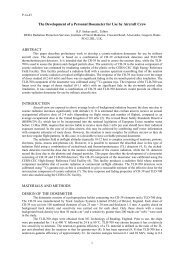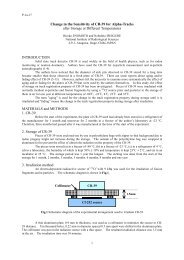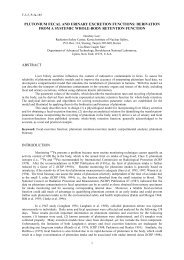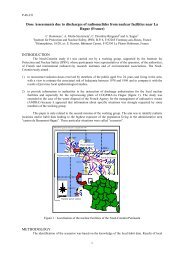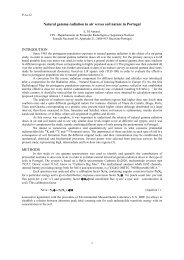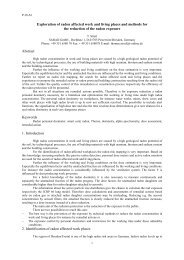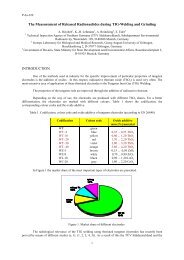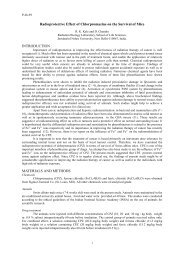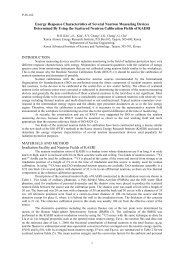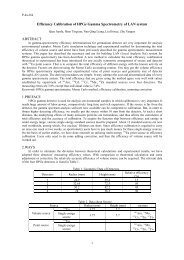The Measurement of Photoneutron in the Vicinity of Siemens Primus ...
The Measurement of Photoneutron in the Vicinity of Siemens Primus ...
The Measurement of Photoneutron in the Vicinity of Siemens Primus ...
You also want an ePaper? Increase the reach of your titles
YUMPU automatically turns print PDFs into web optimized ePapers that Google loves.
P-6a-332<br />
<strong>in</strong>clud<strong>in</strong>g BF 3 proportional counter encased by 3” or 9” diameter PE sphere, was used for mean neutron energy<br />
distribution measurement <strong>in</strong> treatment room. <strong>The</strong> measured po<strong>in</strong>ts were 1,2,3 and 5 meters away from <strong>the</strong><br />
isocenter with field size fully opened and dose rate <strong>of</strong> 500 MU/m<strong>in</strong>. <strong>The</strong> response ratio <strong>of</strong> 9”/3” is a function <strong>of</strong><br />
<strong>the</strong> Hank<strong>in</strong>s calibration factor, and is related to <strong>the</strong> mean neutron energy. [3] Neutron activation analysis <strong>of</strong> Au<br />
foil, which covered with 6” PE, was irradiated <strong>in</strong> <strong>the</strong> x rays field with dose <strong>of</strong> 50 Gy, and was used to determ<strong>in</strong>e<br />
neutron contam<strong>in</strong>ation, and [4] powdered P 2O 5 was used to measure <strong>the</strong> <strong>the</strong>rmal and fast neutron fluence <strong>in</strong> <strong>the</strong> x<br />
ray field. This method utilizes two reactions: (a) 31P(n, )32P, where <strong>the</strong> half life <strong>of</strong> 32P is 14.28 d and emits<br />
max <strong>of</strong> 1.71 MeV. This reaction is ma<strong>in</strong>ly due to <strong>the</strong>rmal neutrons with a cross section <strong>of</strong> 0.19 barn.<br />
(b) 31 P(n,p) 32 Si, where <strong>the</strong> half life <strong>of</strong> 32 Si is 2.62 h and emits max 1.48 MeV with <strong>the</strong> threshold energy <strong>of</strong> 0.7<br />
MeV. <strong>The</strong> can be counted with liquid sc<strong>in</strong>tillator and <strong>the</strong> saturated activity <strong>of</strong> 31 Si and 32 P are related to fast<br />
and <strong>the</strong>rmal neutron fluence, respectively (5).<br />
RESULTS AND DISCUSSION<br />
Environmental survey with a portal rem-meter at all po<strong>in</strong>ts with various irradiated conditions are all <strong>in</strong><br />
background level which is less than 0.04 Sv/h demonstrat<strong>in</strong>g that shield<strong>in</strong>g design is effective for<br />
photoneutrons. <strong>The</strong> mean energy <strong>of</strong> photoneutrons measured by paired BF 3 proportional counters at different<br />
po<strong>in</strong>ts is list <strong>in</strong> Table 1. <strong>The</strong> A,B,C,D and E are o<strong>the</strong>r l<strong>in</strong>acs <strong>in</strong>stalled <strong>in</strong> Taiwan with various energy. It shows<br />
that decreas<strong>in</strong>g mean energy is related to <strong>in</strong>creas<strong>in</strong>g distance to isocenter. For <strong>Siemens</strong> <strong>Primus</strong>, 1, 2, 3 and 5m<br />
away from isocenter are 0.50, 0.20, 0.16 and 0.17 MeV, respectively, which was caused by different levels <strong>of</strong><br />
moderation that depends on <strong>the</strong> schematic layout <strong>of</strong> <strong>the</strong> treatment room. Mean neutron energy produced by high<br />
energy photons was found to be no significant relation to photon energy and types <strong>of</strong> l<strong>in</strong>acs. <strong>The</strong> mean neutron<br />
energy at maze, 0.02 MeV, is much less than that <strong>in</strong> treatment room, which was caused by about additional 5<br />
scatters <strong>in</strong> concrete. <strong>The</strong> importance <strong>of</strong> maze is not only to <strong>in</strong>crease <strong>the</strong> scatters <strong>of</strong> photon but that <strong>of</strong> neutron as<br />
well, that significantly reduce <strong>the</strong> neutron shield<strong>in</strong>g material needed <strong>in</strong> a lead door.<br />
Table 1. Mean neutron energy (MeV) at different po<strong>in</strong>ts <strong>in</strong> treatment room <strong>of</strong> various l<strong>in</strong>acs (4)<br />
Hospital Distance to Ratio <strong>of</strong> 9”/3” Mean neutron<br />
isocenter(m) BF3 energy(MeV)<br />
1 1.02 0.55<br />
A(15MV)<br />
2<br />
3<br />
0.98<br />
0.79<br />
0.50<br />
0.40<br />
Maze 0.16 0.02<br />
B(18MV)<br />
C(10MV)<br />
D(18MV)<br />
E(16MV)<br />
<strong>Siemens</strong><br />
PRIMUS(15MV)<br />
1 1.21 0.65<br />
2 0.95 0.50<br />
3 0.56 0.25<br />
Maze 0.15 0.02<br />
1 0.98 0.50<br />
2 0.77 0.40<br />
3 0.33 0.15<br />
Maze 0.12 0.02<br />
1 0.81 0.50<br />
2 0.63 0.35<br />
3 0.53 0.25<br />
Maze 0.17 0.02<br />
1 0.76 0.40<br />
2 0.55 0.25<br />
3 0.30 0.15<br />
Maze 0.11 0.02<br />
1 1.04 0.50<br />
2 0.57 0.20<br />
3 0.45 0.18<br />
5 0.44 0.17<br />
<strong>The</strong> Au activation analysis by us<strong>in</strong>g Canberra GR1519 N-type HPGe shows three peaks with energy <strong>of</strong><br />
411.8, 355.7 and 333 keV; that are due to activated 198 Au and 196 Au through reactions 197 Au(n, ) 198 Au and<br />
197 ( ,n) 196 Au, respectively. It demonstrated that photoneutrons also exist at isocenter.<br />
2



